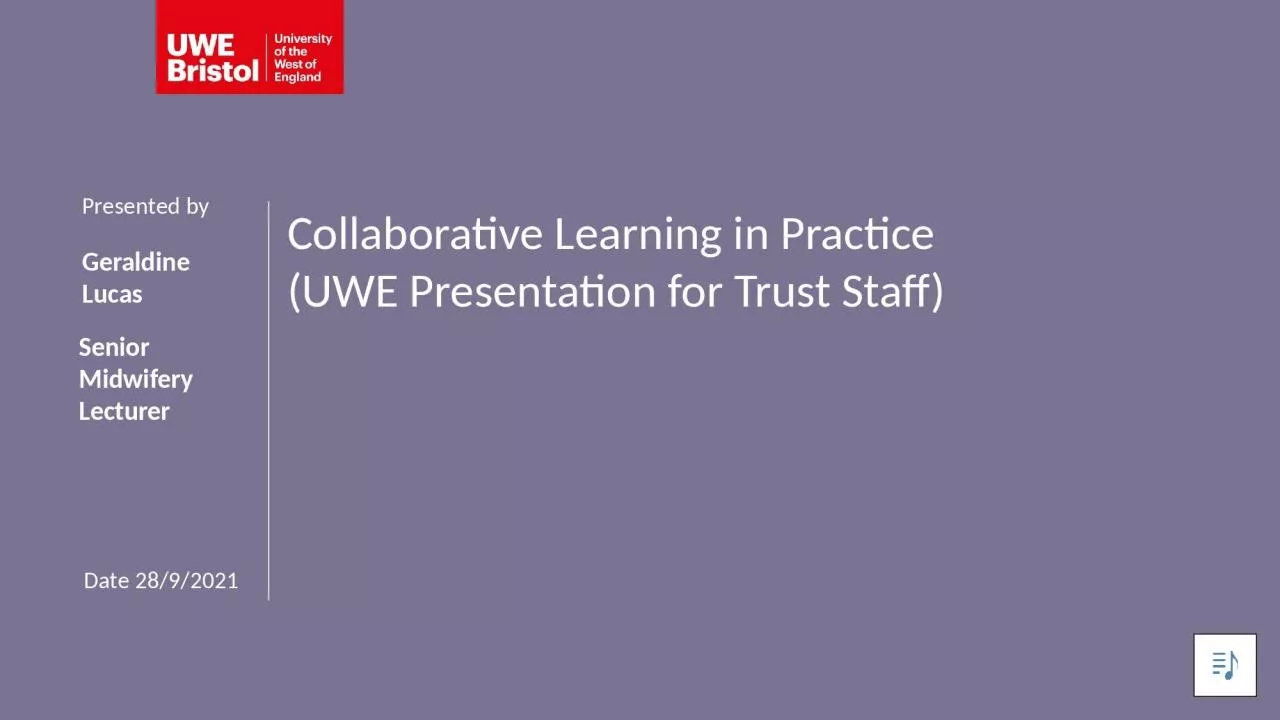

UWE Presentation for Trust Staff Presented by Geraldine Lucas Senior Midwifery Lecturer Date 2892021 Aims amp Objectives of the Session To define the Collaborative learning in Practice model CLIP ID: 1007387
Download Presentation The PPT/PDF document "Collaborative Learning in Practice" is the property of its rightful owner. Permission is granted to download and print the materials on this web site for personal, non-commercial use only, and to display it on your personal computer provided you do not modify the materials and that you retain all copyright notices contained in the materials. By downloading content from our website, you accept the terms of this agreement.
1. Collaborative Learning in Practice(UWE Presentation for Trust Staff)Presented byGeraldine LucasSenior Midwifery LecturerDate 28/9/2021
2. Aims & Objectives of the SessionTo define the Collaborative learning in Practice model (CLIP)To discuss the benefits of the CLIP model for staff and studentsTo discuss current pilot sites for CLIP, and the plans for CLIP to be rolled out across health and social care programmesTo explore what CLIP looks like on a day to day basis Models of coachingCLIP model and the failing studentEscalating concerns
3. Collaborative Learning in Practice (CLIP) ‘CLIP is a collaborative model and involves different levels of students working together, with their practice learning being overseen by a lead coach (Lobo, 2014)’.
4. Background to CLIPButterfield.com
5. Traditional Mentoring modelsTake a few minutes to think about when you last supported a student. Focus on your role and the types of things you did to support the student. What do you think are the differences between mentoring and coaching a student?
6. Differences between Mentoring and Coaching
7. CLIP Model: Change in Roleshttp:altai-touristic.ru/1mg/tour
8. CLIP Model: Students step forward
9. Benefits of the CLIP ModelSustainable model of practice, and develops student leadership skills (Lobo et al, 2004)High quality placement learning-supportive infrastructure of coaching and peer support (Ashworth, 2018)Opportunities to stop and reflect on the shift-enables identification of any learning needsEnhances the care of patients using the care serviceMeeting proficiencies through the support of the coaching model (www.hee.nhs.uk)Students are able to grow in confidence, as they work in different year groups (Ashworth, 2018)
10. Benefits of CLIP Model for StaffHow do you feel that the CLIP model will benefit yourself as a health care professional?
11. Practice Educator Facilitator: Integral to the CLIP ModelDay-day operational delivery of CLIP in practice (Lobo, 2014)Supports students' learningFacilitate aspects of student learningWard visitsSupporting inductions Covering coaches for protected timeSupporting failing studentsSupporting completion of paperworkDevelopment of coaching material in line with University
12. Practice Supervisor: Practice Assessor and Academic AssessorStudents will still be assigned to a practice supervisor for each shift that they work. Students are usually assigned a bay of 6-8 patients and work in a team with a total of three students. Students usually work with peers who are in years 1-3 of the undergraduate course. However, it is possible with CLIP to work with students from the same year group.The practice assessor maintains responsibility for confirming the student’s progress and the academic assessor for progression to the next year
13. What does a shift look like under CLIP?www.istockphotos.com
14. What does a Shift look like under CLIP?httphttps://www.istockphoto.com/photo/medical-team-training-centre-7
15. Learning Outcomes Identified Each ShiftStudents are required to devise a series of learning outcomes for each shiftThese learning outcomes aim to support and focus their learningThe learning outcomes can be used to demonstrate how NMC proficiencies have been achievedThe learning outcomes provide a template for students to consider how they are progressing with their learning
16. Learning Outcomes: Identified each shiftwww.pepperdine.edu/images/infographics/learning-outcomes.svg
17. Golden HourProvides an opportunity to resource locate evidence and resources that could support patient care and learning, and meet student learning objectives
18. Failing StudentPlease ensure that UWE processes are followed. An Academic in Practice (AIP) or Practice Associate Lecturer in Midwifery (PALM) must be contacted.Please review the practice support net An action plan must be commenced and the student should be notified regarding the practice concerns.The UWE failing student protocol must be followedThe student can remain within the CLIP model with the support of a practice supervisor and practice assessor. However, if there are concerns regarding the student remaining in practice, please contact the programme leader for the course.
19. Escalating ConcernsPlease follow UWE processes for escalating concerns in practice
20. CLIP ModelAll students must be assigned to a practice supervisor/ practice assessor. They remain accountable.
21. Summary: CLIP ShiftHandoverStudent team takes the lead. Practice supervisor steps backStudents support and coach one anotherSupport huddles during the day‘Golden hour’-enables resource locating of materials that can assist learning and developmentOpportunities for reflective sessions
22. Coaching Models: TGROWwww.intentionaltravel
23. The T-GROW Model (Personalised Care)Please take a look at this short clip by Lancashire Trust about T-GROWhttps://www.youtube.com/watch?v=9afICnERcuk